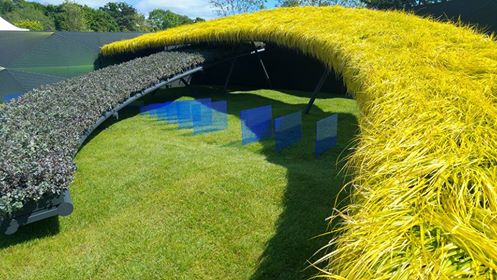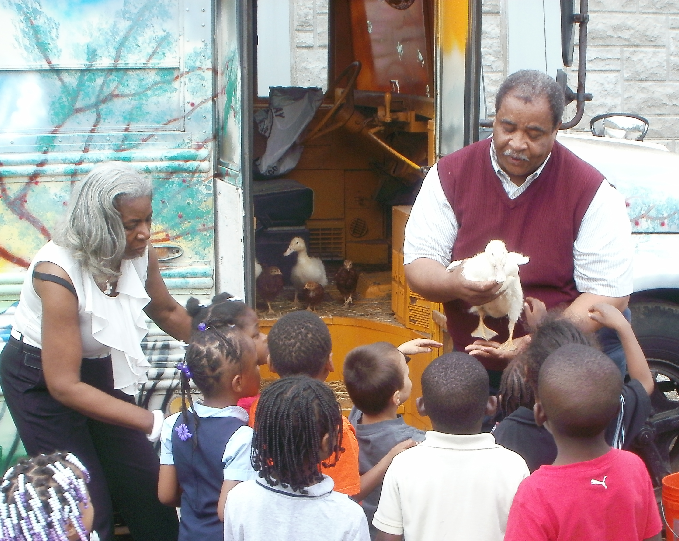June 5, 2016 – Wisconsin Vegetables; Irish Bridge; South Side Nature
Holly and Joey Baird are the Wisconsin Vegetable Gardener(s)
There’s a lot of good growing that happens north of Illinois, regardless of the fact that my Milwaukee friends often talk about how their season is usually two or three weeks behind ours here in the Windy City.
But that doesn’t seem to bother folks like Holly and Joey Baird, who are busily creating a horticultural empire in the Badger State. They are the proprietors of a number of podcast, video, and web sites, collectively known as The Wisconsin Vegetable Gardener. In fact, there’s a rumor that they will launch their own radio show next year…but you didn’t hear that from me.
From their website:
 Along with traditional ground gardening they also grow indoors year-round using up and coming methods along with winter growing in cold frames and low tunnels.
Along with traditional ground gardening they also grow indoors year-round using up and coming methods along with winter growing in cold frames and low tunnels.
Their goal through their videos and social media pages is to show the average person how easy it is to grow food, store food, and reuse everyday items. Their motto is “for the average gardener, simple home living, and using what you already have.”
That is right up my alley, as you might have surmised, and, in fact, this year I was absorbed into their burgeoning empire: I began doing a series of environmental reports on their bi-weekly podcast. You can check out The Wisconsin Vegetable Gardener Podcast 24 (including my latest enviro report) here.
Or, if you just want a good “how-to” video, take a look at How we Grow our Tomatoes- Revised The Wisconsin Vegetable Gardener, which just came out on May 31.
Joey and Holly join me on my own show this morning. I hope I don’t have to pay royalties.
Bridging the Gap between Chicago and Ireland
Pat FitzGerald has been a friend of mine for a number of years, though we have never met. Back when I was at Progresso Radio, we began following each other on the Facebook appliance and the Twitter contrivance.
He runs an outfit called, not so coincidentally, Fitzgerald Nurseries, which is located in the Republic of Ireland, and which is one of the reasons why we have never met face to face. They say they have developed a unique range of plants suitable for all year round colour (Irish spelling) in small garden spaces, planters and containers.
Well, this year they teamed up the Chicago Park District to put together a display for an event in Ireland called Bloom, which is celebrating its 10th anniversary. The site of Bloom this year is Phoenix Park in Dublin, Ireland, hence the name at Bloom In The Park 2016.
The project itself is called Chicago Bridge the Gap Garden, a commemoration of all the Irish Emigrants that crossed the ocean in search of a brighter future. A fundraiser that benefits the Chicago Parks foundation explains the installation:
 Our design features two, large living sculptures that can be seen as two separate bridges. One bridge will represent Ireland while the other bridge represents the United States. The two bridges appear to intersect, yet they do not connect, there remains a gap. Using the two viewing sides to observe the structures crossing the garden, patrons will be able to see through the negative space created by the bridges and notice patrons viewing from the other side. Without anticipating a connection, the patrons are now part of the garden and part of the story by bridging the gap.
Our design features two, large living sculptures that can be seen as two separate bridges. One bridge will represent Ireland while the other bridge represents the United States. The two bridges appear to intersect, yet they do not connect, there remains a gap. Using the two viewing sides to observe the structures crossing the garden, patrons will be able to see through the negative space created by the bridges and notice patrons viewing from the other side. Without anticipating a connection, the patrons are now part of the garden and part of the story by bridging the gap.
Each bridge is populated solely by one kind of plant. One is EverColor® Carex Everillo which was bred by FitzGerald and is available in garden centers and box stores throughout the U.S. Everillo, which is a chartreuse colored hardy sedge, is part of FitzGeralds EverColor® range (www.evercolorplants.com) which is Ireland’s most successful international ornamental plant export, selling over 2 million plants each year in 26 countries .
The other is Sunsparkler Sedum Dazzleberry from USA breeder Chris Hansen of Garden Solutions in Holland, Michigan. Having two nursery plantsmen from different sides of the Atlantic once again exemplifies the garden theme Bridging the Gap.
As you can see from the photo, it’s a stunning design, and it captured a Gold award from the event. Pat Fitzgerald joins me on the program this morning, along with two of the Chicago Park District folks who were involved in the project: Peggy Stewart, Assistant Director of Culture, Arts and Nature, and Matthew Barrett, Deputy Director of Conservatories.
Eden Place Nature Center keeps on keepin’ on
Go to the website for Eden Place Nature Center and you’ll see a lot of the same stuff that many not-for-profit ventures have on their sites: “Eden Place is dedicated to growing opportunities for learning, recreation, health and employment in the areas of nature conservation and urban agriculture.”
But unless you know Michael Howard, the driving force behind Eden Place, and have talked to him at length, you miss the reality of what it’s like to try to create something out of nothing on the south side of Chicago.
Wait. It was worse than that. Howard and friends have created something out of less than nothing. Because when they started, all they had was an illegal, toxic dumping ground in the Fuller Park neighborhood. How toxic? Enough so that Howard’s son had high levels of lead in his blood.
Of course, the lead poisoning wasn’t coming just from that lot, but that’s where Michael Howard drew the line and decided it was time to give his kids and all of the people in the community a chance to observe nature–any kind of nature–in their own neighborhood. It took three years for the citizen volunteers just to remove the construction debris. Then eight inches of top soil were added. In 2003, Eden Place Nature Center opened.
Thirteen years later, Eden Place hosts a range of programs that help urban residents connect with nature, grow healthy food, and preserve the region’s biodiversity. These programs include Eden Place Farms, Wild Indigo Nature Explorations, Monarch Propagation and Monitoring, Dr. George Washington Carver Research Station, Earth Day celebrations, a Pumpkin Festival and more.
You can go there and watch kids transfixed by the site of ducks and  chickens and goats and other farm animals.
chickens and goats and other farm animals.
Mission accomplished, right? Not so much. Money is always an issue (you can contribute to Eden Place here), and after operating out of a trailer for years, Michael Howard wants a permanent Nature Center for Eden Place that will house classrooms and after school programming for the community. He has already built the foundation of the building–literally–and now he needs to fund the rest of it.
That’s where one of their sponsors comes in. Howard joins me this morning to talk about an upcoming fundraiser sponsored by the Brookfield Zoo, which might finally get the job done. He’s determined guy. And a patient guy. But I know that patience has its limits, too. I welcome him, once again, to my program.

